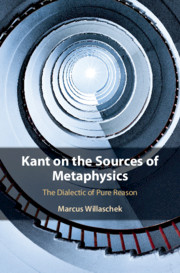Book contents
- Kant on the Sources of Metaphysics
- Kant on the Sources of Metaphysics
- Copyright page
- Dedication
- Contents
- Note on References and Citations
- Preface
- Introduction
- Part I From Reason to Metaphysics
- Introduction to Part I
- 1 Kant’s Conceptions of Reason and Metaphysics
- 2 The Logical Use of Reason and the Logical Maxim
- 3 The Supreme Principle of Pure Reason
- 4 Understanding the Transition Passage (A307–8/B364)
- 5 The Transition from the Logical Maxim to the Supreme Principle of Pure Reason
- Conclusion to Part I: The Transition from the Logical Maxim to the (Constitutive) Supreme Principle and the Rational Sources Account
- Part II The Other Side of the Transcendental Dialectic
- Postscript
- Bibliography
- Index of Names
- Index of Subjects
4 - Understanding the Transition Passage (A307–8/B364)
from Part I - From Reason to Metaphysics
Published online by Cambridge University Press: 09 November 2018
- Kant on the Sources of Metaphysics
- Kant on the Sources of Metaphysics
- Copyright page
- Dedication
- Contents
- Note on References and Citations
- Preface
- Introduction
- Part I From Reason to Metaphysics
- Introduction to Part I
- 1 Kant’s Conceptions of Reason and Metaphysics
- 2 The Logical Use of Reason and the Logical Maxim
- 3 The Supreme Principle of Pure Reason
- 4 Understanding the Transition Passage (A307–8/B364)
- 5 The Transition from the Logical Maxim to the Supreme Principle of Pure Reason
- Conclusion to Part I: The Transition from the Logical Maxim to the (Constitutive) Supreme Principle and the Rational Sources Account
- Part II The Other Side of the Transcendental Dialectic
- Postscript
- Bibliography
- Index of Names
- Index of Subjects
Summary
Having investigated the Logical Maxim and the Supreme Principle, Chapter 4 turns to the transition from the former to latter. In a suggestive passage from the Introduction to the Transcendental Dialectic, Kant claims that the Logical Maxim can become a principle of pure reason only by our assuming the Supreme Principle. In order to understand this, we look, first, at the final paragraph of the Introduction, where Kant raises the question of whether the Supreme Principle is ‘objectively valid,’ and then at the Appendix to the Transcendental Dialectic, where he also claims of various ‘logical principles’ that they presuppose ‘transcendental principles,’ which we must therefore ‘assume.’ In light of the distinction between the regulative and the constitutive use of principles, there are two very different ways of understanding what it means to ‘assume’ a principle. Our result will be that the transition to the metaphysical Supreme Principle involves two steps not made explicit by Kant: one from the Logical Maxim to the regulative use of the Supreme Principle, and another from the regulative use of the Supreme Principle to its constitutive use.
Keywords
- Type
- Chapter
- Information
- Kant on the Sources of MetaphysicsThe Dialectic of Pure Reason, pp. 103 - 126Publisher: Cambridge University PressPrint publication year: 2018

